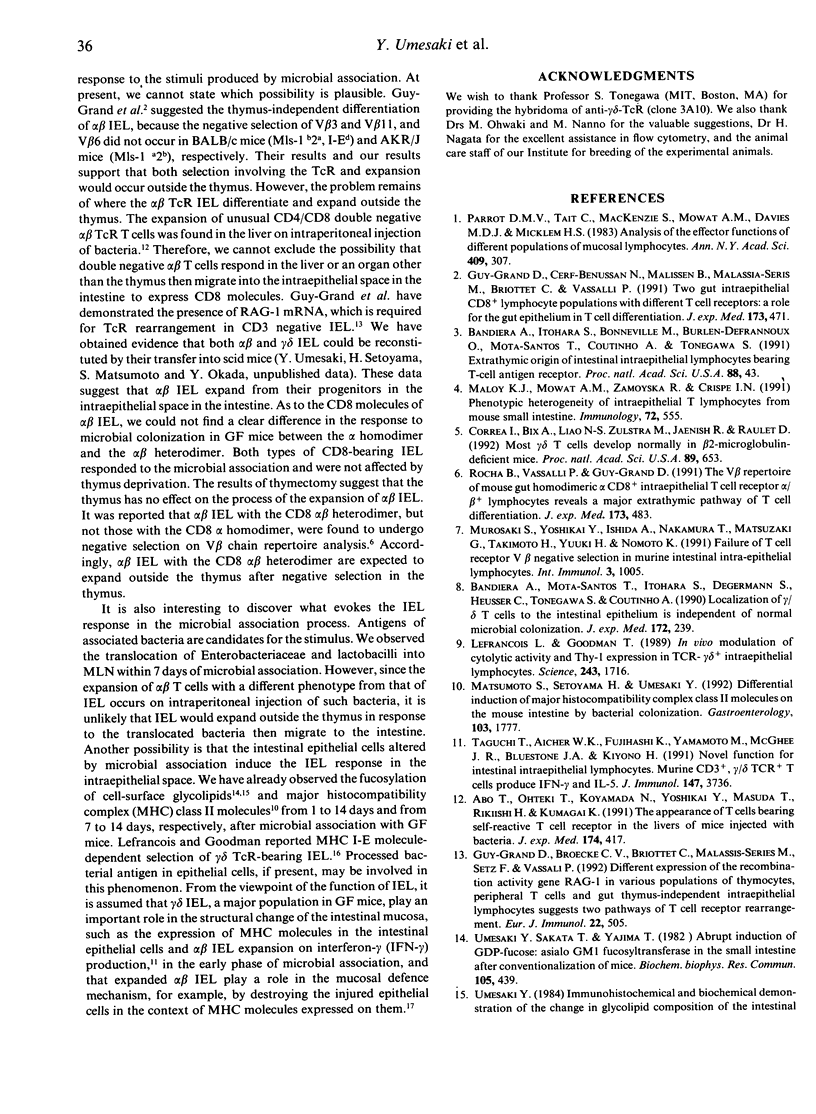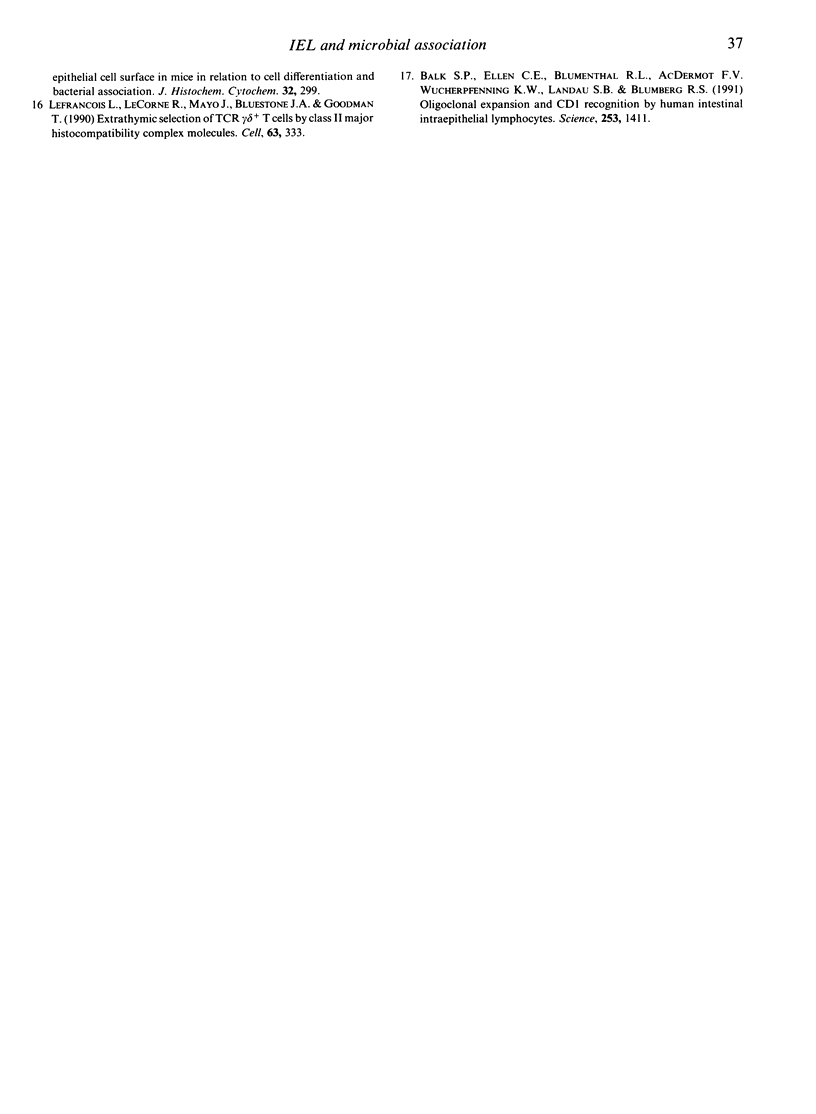Abstract
A large proportion of intestinal intraepithelial lymphocytes (IEL) comprises alpha beta and gamma delta T-cell receptor (TcR)-bearing T cells. The numbers of alpha beta and gamma delta IEL are reported to be very different between germ-free and conventional microbial conditions. In this study, we investigated the kinetics of both types of TcR-bearing cells after microbial colonization in germ-free mice and the influence of thymus deprivation on IEL populations during the microbial association process. Immediately after association with microbes in germ-free animals, the number of alpha beta TcR-bearing IEL gradually increased. Fourteen days after microbial association the number of alpha beta IEL equalled that of gamma delta TcR-bearing IEL. Approximately 1 month after microbial association, the number of alpha beta IEL was several times greater than that of gamma delta IEL, having almost reached the level in conventional mice reared in a conventional animal room after birth. On the other hand the number of gamma delta IEL hardly changed throughout this microbial association process. Two-colour analysis involving anti-alpha beta TcR and anti-Lyt-2 or Lyt-3 antibodies showed that the major fraction of IEL that increased after microbial association comprised alpha beta TcR-bearing T cells expressing CD8 antigen composed of a homodimer of alpha-chains, which was not detected in other gut associated-lymphoid tissues (GALT) such as Peyer's patch, mesenteric lymph node and lamina propria tissue. The number of alpha beta T cells in these GALT increased within 1 week more quickly than that of IEL. The increase in alpha beta IEL after microbial association was not prevented by thymectomy. These results strongly suggest that the progenitors of alpha beta TcR-bearing IEL expand outside the thymus in response to microbial colonization in germ-free mice.
Full text
PDF





Selected References
These references are in PubMed. This may not be the complete list of references from this article.
- Abo T., Ohteki T., Seki S., Koyamada N., Yoshikai Y., Masuda T., Rikiishi H., Kumagai K. The appearance of T cells bearing self-reactive T cell receptor in the livers of mice injected with bacteria. J Exp Med. 1991 Aug 1;174(2):417–424. doi: 10.1084/jem.174.2.417. [DOI] [PMC free article] [PubMed] [Google Scholar]
- Balk S. P., Ebert E. C., Blumenthal R. L., McDermott F. V., Wucherpfennig K. W., Landau S. B., Blumberg R. S. Oligoclonal expansion and CD1 recognition by human intestinal intraepithelial lymphocytes. Science. 1991 Sep 20;253(5026):1411–1415. doi: 10.1126/science.1716785. [DOI] [PubMed] [Google Scholar]
- Bandeira A., Itohara S., Bonneville M., Burlen-Defranoux O., Mota-Santos T., Coutinho A., Tonegawa S. Extrathymic origin of intestinal intraepithelial lymphocytes bearing T-cell antigen receptor gamma delta. Proc Natl Acad Sci U S A. 1991 Jan 1;88(1):43–47. doi: 10.1073/pnas.88.1.43. [DOI] [PMC free article] [PubMed] [Google Scholar]
- Bandeira A., Mota-Santos T., Itohara S., Degermann S., Heusser C., Tonegawa S., Coutinho A. Localization of gamma/delta T cells to the intestinal epithelium is independent of normal microbial colonization. J Exp Med. 1990 Jul 1;172(1):239–244. doi: 10.1084/jem.172.1.239. [DOI] [PMC free article] [PubMed] [Google Scholar]
- Correa I., Bix M., Liao N. S., Zijlstra M., Jaenisch R., Raulet D. Most gamma delta T cells develop normally in beta 2-microglobulin-deficient mice. Proc Natl Acad Sci U S A. 1992 Jan 15;89(2):653–657. doi: 10.1073/pnas.89.2.653. [DOI] [PMC free article] [PubMed] [Google Scholar]
- Guy-Grand D., Cerf-Bensussan N., Malissen B., Malassis-Seris M., Briottet C., Vassalli P. Two gut intraepithelial CD8+ lymphocyte populations with different T cell receptors: a role for the gut epithelium in T cell differentiation. J Exp Med. 1991 Feb 1;173(2):471–481. doi: 10.1084/jem.173.2.471. [DOI] [PMC free article] [PubMed] [Google Scholar]
- Guy-Grand D., Vanden Broecke C., Briottet C., Malassis-Seris M., Selz F., Vassalli P. Different expression of the recombination activity gene RAG-1 in various populations of thymocytes, peripheral T cells and gut thymus-independent intraepithelial lymphocytes suggests two pathways of T cell receptor rearrangement. Eur J Immunol. 1992 Feb;22(2):505–510. doi: 10.1002/eji.1830220232. [DOI] [PubMed] [Google Scholar]
- Lefrancois L., Goodman T. In vivo modulation of cytolytic activity and Thy-1 expression in TCR-gamma delta+ intraepithelial lymphocytes. Science. 1989 Mar 31;243(4899):1716–1718. doi: 10.1126/science.2564701. [DOI] [PubMed] [Google Scholar]
- Lefrancois L., LeCorre R., Mayo J., Bluestone J. A., Goodman T. Extrathymic selection of TCR gamma delta + T cells by class II major histocompatibility complex molecules. Cell. 1990 Oct 19;63(2):333–340. doi: 10.1016/0092-8674(90)90166-c. [DOI] [PubMed] [Google Scholar]
- Maloy K. J., Mowat A. M., Zamoyska R., Crispe I. N. Phenotypic heterogeneity of intraepithelial T lymphocytes from mouse small intestine. Immunology. 1991 Apr;72(4):555–562. [PMC free article] [PubMed] [Google Scholar]
- Matsumoto S., Setoyama H., Umesaki Y. Differential induction of major histocompatibility complex molecules on mouse intestine by bacterial colonization. Gastroenterology. 1992 Dec;103(6):1777–1782. doi: 10.1016/0016-5085(92)91434-6. [DOI] [PubMed] [Google Scholar]
- Murosaki S., Yoshikai Y., Ishida A., Nakamura T., Matsuzaki G., Takimoto H., Yuuki H., Nomoto K. Failure of T cell receptor V beta negative selection in murine intestinal intra-epithelial lymphocytes. Int Immunol. 1991 Oct;3(10):1005–1013. doi: 10.1093/intimm/3.10.1005. [DOI] [PubMed] [Google Scholar]
- Parrott D. M., Tait C., MacKenzie S., Mowat A. M., Davies M. D., Micklem H. S. Analysis of the effector functions of different populations of mucosal lymphocytes. Ann N Y Acad Sci. 1983 Jun 30;409:307–320. doi: 10.1111/j.1749-6632.1983.tb26879.x. [DOI] [PubMed] [Google Scholar]
- Rocha B., Vassalli P., Guy-Grand D. The V beta repertoire of mouse gut homodimeric alpha CD8+ intraepithelial T cell receptor alpha/beta + lymphocytes reveals a major extrathymic pathway of T cell differentiation. J Exp Med. 1991 Feb 1;173(2):483–486. doi: 10.1084/jem.173.2.483. [DOI] [PMC free article] [PubMed] [Google Scholar]
- Taguchi T., Aicher W. K., Fujihashi K., Yamamoto M., McGhee J. R., Bluestone J. A., Kiyono H. Novel function for intestinal intraepithelial lymphocytes. Murine CD3+, gamma/delta TCR+ T cells produce IFN-gamma and IL-5. J Immunol. 1991 Dec 1;147(11):3736–3744. [PubMed] [Google Scholar]
- Umesaki Y. Immunohistochemical and biochemical demonstration of the change in glycolipid composition of the intestinal epithelial cell surface in mice in relation to epithelial cell differentiation and bacterial association. J Histochem Cytochem. 1984 Mar;32(3):299–304. doi: 10.1177/32.3.6693758. [DOI] [PubMed] [Google Scholar]
- Umesaki Y., Sakata T., Yajima T. Abrupt induction of GDP-fucose: asialo GM1 fucosyltransferase in the small intestine after conventionalization of germ-free mice. Biochem Biophys Res Commun. 1982 Mar 30;105(2):439–443. doi: 10.1016/0006-291x(82)91453-x. [DOI] [PubMed] [Google Scholar]


